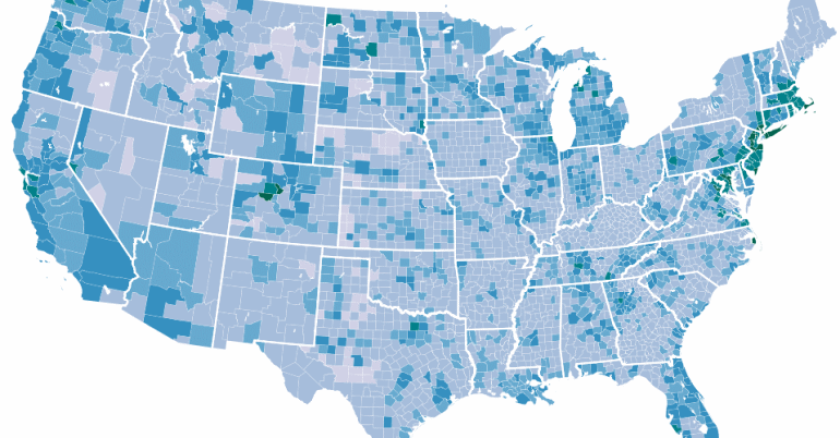- Checking on the National Broadband Map 3.0
- Maryland Announces $27M in Internet Device Investment
- Colorado Releases Broadband Workforce Plan
- California Hiring Statewide Library Broadband Access Grants Manager
- Senators Author New Bill to Lower Broadband Costs for Rural, Tribal Areas
CHECKING ON THE NATIONAL BROADBAND MAP 3.0
As U.S. families prepare to celebrate Thanksgiving, the Federal Communications Commission (FCC) marks this time of the year with the release of new broadband maps. Last November, the FCC released the first much-anticipated map, but this was only the first step in a long process to ensure the accuracy of the data portrayed. In May 2023, the maps were updated.
The third iteration of the National Broadband Map is now publicly available, continuing to build on federal efforts to accurately represent the state of broadband access across the nation with data. In this new version, data reveals that just over 7.2 million locations lack Internet access, down from the 8.3 million that were shown to lack access when the second map was released. The new iteration reveals that broadband build-outs are already occurring, even prior to deployments that will be funded by the Bipartisan Infrastructure Law.
“With each refresh of the map we are more confident in the accuracy of the data,” FCC Chairwoman Jessica Rosenworcel wrote in a note about the new release. “The work continues and we will continue to collect updated data and release new maps, just as Congress intended.”
The new iteration also reveals the value of participation in the challenge process. Roughly 4.8 million challenges to provider-reported availability information and over 1.5 million accepted location challenges have helped the FCC correct data and improve accuracy.
This new iteration marks the progress that has been made already in this space and sets the stage for the work to come. (Julia Edinger)
MARYLAND ANNOUNCES $27M IN INTERNET DEVICE INVESTMENT
In state news, Maryland Gov. Wes Moore has announced a $27 million investment to expand access to Internet-enabled devices for underserved Maryland households through the Office of Statewide Broadband’s Connected Devices Program.
This investment will make more than 133,000 laptops available for distribution to 27 local governments and their partners. All 27 of the jurisdictions that applied were awarded grants. In the applications, requests ranged from 10 to 30,000 devices. Most of the jurisdictions that received awards also received funding to help support the device distribution.
Also this week, Moore announced that drafts of the state broadband plan have been developed. Marylanders are encouraged to submit feedback during the public comment window that ends Dec. 2. Input will be reviewed before finalized documents are submitted to the National Telecommunications and Information Administration. (Julia Edinger)
COLORADO RELEASES BROADBAND WORKFORCE PLAN
The Colorado Broadband Office and the Office of the Future of Work together have unveiled a plan to address workforce obstacles that might negatively impact broadband deployment. The public can comment on this plan until Nov. 27.
The plan aims to support the equitable deployment of Broadband Equity, Access and Deployment (BEAD) program funding. It is divided into three sections: the state of the broadband workforce, equitable training in workforce development, and broadband workforce development strategies and milestones.
Among other things, the plan underlines a state goal of having 3,000 workers enter training for a broadband-related field by December 2025, ultimately preparing the state to meet its goal of connecting all households by 2027. (Julia Edinger)
CALIFORNIA HIRING STATEWIDE LIBRARY BROADBAND ACCESS GRANTS MANAGER
The California State Library is hiring a statewide library broadband access grants manager, according to a new job posting.
At the heart of this job is the Corporation for Education Network Initiatives in California (CENIC), which is a high-capacity 8,000-mile fiber-optic network that the public libraries there can use to connect with to get reliable and affordable fast Internet. California then provides ongoing grants to public libraries so they can maintain their membership in CENIC.
The job would be helping with all of this. As of now, a successful applicant would enter into an agreement to serve in the role for three-and-a-half years.
More information can be found here. (Zack Quaintance)
SENATORS AUTHOR NEW BILL TO LOWER BROADBAND COSTS FOR RURAL, TRIBAL AREAS
Finally, a bipartisan group of senators has introduced the Lowering Broadband Costs for Consumers Act of 2023.
This legislation would direct the Federal Communications Commission (FCC) to require contributions from broadband providers to the Universal Service Fund, thereby reducing the financial burden on consumers and providers specifically in rural and tribal areas.
The text of the bill can be found here. (Zack Quaintance)
















